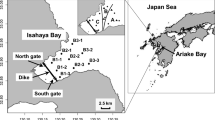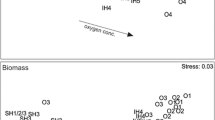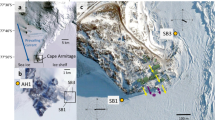Abstract
Improved benthic conditions compared to the 1990s were found during benthic investigations, including sediment and benthic macrofauna in the inner Stockholm archipelago during 2008. In the 1990s, these areas were dominated by black and laminated surface sediments and very sparse fauna. A clear relationship was found when comparing sediment status with the benthic macrofauna. Reduced surface sediment and impoverished macroinvertebrate community was only found at one sampling station representing an enclosed part of the inner archipelago, whereas the other seven stations, with depths ranging from 20 to 50 m, had oxidized surface sediments and considerable biomasses of benthic macrofauna (6–65 g m−2) dominated by the invading polychaete Marenzelleria neglecta. An extrapolation of the results shows that, within the investigated area, the coverage of reduced surface sediments had decreased from approximately 17% in the late 1990s to 4% in 2008.





Similar content being viewed by others
References
Balzer, W. 1984. Organic matter degradation and biogenic element cycling in nearshore sediment (Kiel Bight). Limnology and Oceanography 29: 1231–1246.
Boesch D., R. Hecky, C. O’Melia, D. Schindler, and S. Seitzinger. 2006. Eutrophication of Swedish seas. Swedish Environmental Protection Agency Report 5509. www.naturvardsverket.se.
Bonsdorff, E., C. Rönnberg, and K. Aarnio. 2002. Some ecological properties in relation to eutrophication in the Baltic Sea. Hydrobiologia 475 (476): 371–377.
Brattberg, G. 1986. Decreased phosphorus loading changes phytoplankton composition and biomass in the Stockholm archipelago. Vatten 42: 141–152.
Cederwall, H., V. Jermakovs, and G. Lagzdins. 1999. Long-term changes in the soft-bottom macrofauna of the Gulf of Riga. ICES Journal of Marine Science, Supplement 56: 41–48.
Conley, D.J., H.W. Paerl, R.W. Howar, D.F. Boesch, S.P. Seitzinger, K.E. Havens, C. Lancelot, and G.E. Likens. 2009. Eutrophication: Time to adjust expectations—response. Science 324: 724–725.
Diaz, R.J., and R. Rosenberg. 2008. Spreading dead zones and consequences for marine ecosystems. Science 321: 926–929.
Eilola, K., H.E.M. Meier, and E. Almroth. 2009. On the dynamics of oxygen, phosphorus and cyanobacteria in the Baltic Sea: A model study. Journal of Marine Systems 75: 163–184.
Engqvist, A., and O. Andrejev. 2003. Water exchange of the Stockholm archipelago—a cascade framework modelling approach. Journal of Sea Research 49: 275–294.
Håkanson, L., and A.C. Bryhn. 2008. Eutrophication in the Baltic Sea, present situation, nutrient transport processes, remedial strategies. Berlin: Springer Verlag, 264 pp.
Håkanson, L., A. Gyllenhammar, and A. Brolin. 2004. A dynamic model to predict sedimentation and suspended particulate matter in coastal areas. Ecological Modelling 175: 353–384.
Helsel, D.R., and R.M. Hirsch. 2002. Statistical methods in water resources techniques of water resources investigations (Book 4, Chapter A3). U.S. Geological Survey, 522 pp.
Hietanen, S., A.O. Laine, and K. Lukkari. 2007. The complex effects of the invasive polychaetes Marenzelleria spp. on benthic nutrient dynamics. Journal of Experimental Marine Biology and Ecology 352: 89–102.
Jones, P.D. 2006. Water qualities and fisheries in the Mersey estuary, England: A historical perspective. Marine Pollution Bulletin 53: 144–154.
Jonsson, P. (ed.), J. Persson, and P. Holmberg. 2003. The seafloor of the Baltic Sea archipelagoes. Swedish Environmental Protection Agency Report No: 5212. ISBN 91-620-52512-8, 112 pp (in Swedish).
Jönsson, A., M. Lindström, R. Carman, C.-M. Mörth, M. Meili, and Ö. Gustafsson. 2005. Evaluation of the Stockholm Archipelago sediments, northwestern Baltic Sea Proper, as a trap for freshwater runoff organic carbon. Journal of Marine Systems 56: 167–178.
Jonsson, P., C. Rappe, L.-O. Kjeller, A. Kierkegaard, and L. Håkanson. 1993. Pulp-mill related polychlorinated organic compounds in Baltic Sea sediments. Ambio 22: 37–43.
Karlson, K., R. Rosenberg, and E. Bonsdorff. 2002. Temporal and spatial large-scale effects of eutrophication and oxygen deficiency on benthic fauna in Scandinavian and Baltic waters—a review. Oceanography and Marine Biology: An Annual Review 40: 427–489.
Karlsson, M., M. Malmaeus, P. Jonsson, and E. Rydin. 2009. Sediment studies in the Stockholm archipelago 2008. IVL Swedish Environmental Research Institute. Report B1894. www.ivl.se.
Knudsen, M. 1900. Ein hydrographischer Lehrsatz. Annalen der Hydrographie und Maritimen Meteorologie 28(7): 316–320 (in German).
Koop, K., W.R. Boynton, F. Wulff, and R. Carman. 1990. Sediment-water oxygen and nutrient exchanges along a depth gradient in the Baltic Sea. Marine Ecology Progress Series 63: 65–77.
Kotta, J., V. Lauringson, and I. Kotta. 2007. Response of zoobenthic communities to changing eutrophication in the northern Baltic Sea. Hydrobiologia 580: 97–108.
Laine, A.O., K. Luodekari, M. Poikonen, and M. Viitasalo. 2003. A comparison between 1928 and 2000 indicates major changes in macrozoobenthos species composition and abundance on the SW coast of Finland (Baltic Sea). Proceedings of the Estonian Academy of Science, Biology Ecology 52: 3–16.
Lännergren, C., B. Eriksson, and A. Stehn. 2007. Surveys in the Stockholm archipelago 2006. Stockholm Vatten Report, Diary No: 242–1039, 239 pp (in Swedish).
Lännergren, C., B. Eriksson, and A. Stehn. 2009. Surveys in the Stockholm archipelago 2008. Stockholm Vatten Report, Diary No: 09SV139, 243 pp (in Swedish).
Malmaeus, J.M., E. Rydin, P.O. Jonsson, D. Lindgren, and O.M. Karlsson. 2009. Estimating the amount of mobile phosphorus in Baltic coastal soft sediments of central Sweden. Manuscript.
Mee, L. 2006. Reviving dead zones. Scientific American 295: 78–85.
Meili, M., P. Jonsson, M. Lindström, and P. Holmberg. 2000. Accumulation of Chernobyl Cs-137 in coastal archipelagos of the Baltic Sea. In The radiological exposure of the population of the European community to radioactivity in the Baltic Sea. Marina-Balt project, ed. S.P. Nielsen, 415–420. Proceedings of a seminar held at Hasseludden Conference Centre, Stockholm, 9–11 June 1998. EUR 19200 EN, ISBN 92-828-7864-3.
Mortimer, C.H. 1941. The exchange of dissolved substances between mud and water in lakes. Journal of Ecology 29: 280–329.
Nilsson, P., M. Jansson, and L. Brydsten. 2003. Retention and long term accumulation of EOCl from pulp mill effluents in a Baltic Sea recipient. Water, Air, and Soil Pollution 143: 225–243.
Parker, C.A., and J.E. O’Reilly. 1991. Oxygen depletion in Long Island Sound: A historical perspective. Estuaries 14: 248–264.
Persson, J., and P. Jonsson. 2000. Historical development of laminated sediments—an approach to detect soft sediment ecosystem changes in the Baltic Sea. Marine Pollution Bulletin 40: 122–134.
Perus, J., and E. Bonsdorff. 2004. Long-term changes in macrozoobenthos in the Åland archipelago, northern Baltic Sea. Journal of Sea Research 52: 45–56.
Renberg, I. 1981. Formation, structure and visual appearance of iron-rich, varved lake sediments. Verhandlungen des Internationalen Verein Limnologie 21: 94–101.
Rosenberg, R., S. Agrenius, B. Hellman, H.C. Nilsson, and K. Norling. 2002. Recovery of marine benthic habitats and fauna in a Swedish fjord following improved oxygen conditions. Marine Ecology Progress Series 234: 43–53.
Rosenberg, R., M. Blomquist, H.C. Nilsson, H. Cederwall, and A. Dimming. 2004. Marine quality assessment by use of benthic species-abundance distributions: A proposed new protocol within the European Union Water Framework Directive. Marine Pollution Bulletin 49: 728–739.
Rosenberg, R., and R.J. Diaz. 1993. Sulfur Bacteria (Beggiatoa spp.) mats indicate hypoxic conditions in the Inner Stockholm Archipelago. Ambio 22: 32–36.
Savage, C., R. Elmgren, and U. Larsson. 2002. Effects of sewage-derived nutrients on an estuarine macrobenthic community. Marine Ecology Progress Series 243: 67–82.
Schaffner, L.C., P. Jonsson, R.J. Diaz, R. Rosenberg, and P. Gapcynski. 1992. Benthic communities and bioturbation history of estuarine and coastal systems: Effects of hypoxia and anoxia. Science of the Total Environmental Supplement 1992: 1001–1016.
SLU. 2009. Department of Aquatic Science and Assessment, Swedish University of Agricultural Sciences. www.ma.slu.se.
SMHI. 2003. Depth data for sea areas 2003. Swedish Meteorological and Hydrological Institute Oceanography Report No 73: ISSN 0283-7714, Norrköping, 69 p (in Swedish).
Wasmund, N., G. Nausch, and B. Schneider. 2005. Primary production rates calculated by different concepts—an opportunity to study the complex production system in the Baltic Proper. Journal of Sea Research 54: 244–255.
Zettler, M.L. 1996. Successful establishment of the spionid polychaete, Marenzelleria viridis (Verrill, 1873), in the Darss-Zingst estuary (southern Baltic) and its influence on the indigenous macrozoobenthos. Archive of Fishery and Marine Research 43: 273–284.
Acknowledgments
This study was financed by the Swedish Environmental Protection Agency through Grant 501 0805. Karlsson and Lindgren also had funding from the Faculty of Science and Technology, Uppsala University. We are grateful to Christer Lännergren, Stockholm Vatten for sharing empirical data on water quality and STP discharges. Wind data, discharge data for River Norrström, and ice cover data for Trälhavet Bay were provided by Swedish Meteorological and Hydrological Institute (SMHI), which is gratefully acknowledged. Dr Gunnar Andersson, The National Veterinary Institute, and Dr Lennart Norell, Swedish University of Agricultural Sciences and Magnus Rahmberg IVL Swedish Environmental Research Institute are thanked for statistical guidance. We also want to thank Prof. Lars Håkanson, Uppsala University for valuable discussions and two anonymous reviewers that gave constructive critique on previous version of the manuscript.
Author information
Authors and Affiliations
Corresponding author
Rights and permissions
About this article
Cite this article
Karlsson, O.M., Jonsson, P.O., Lindgren, D. et al. Indications of Recovery from Hypoxia in the Inner Stockholm Archipelago. AMBIO 39, 486–495 (2010). https://doi.org/10.1007/s13280-010-0079-3
Received:
Revised:
Accepted:
Published:
Issue Date:
DOI: https://doi.org/10.1007/s13280-010-0079-3




